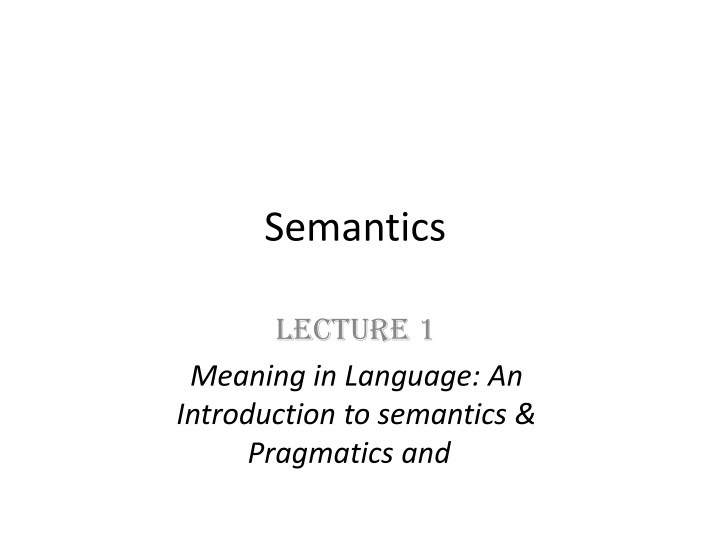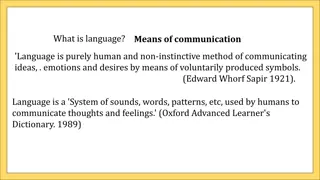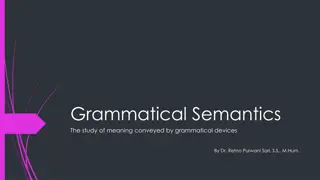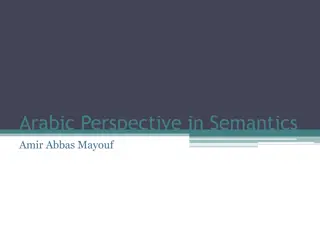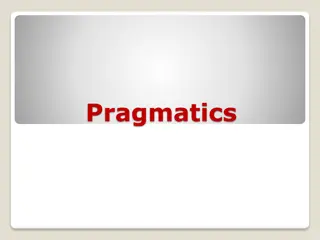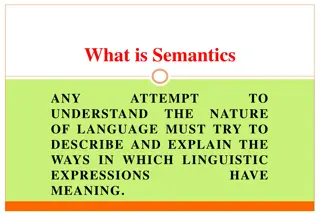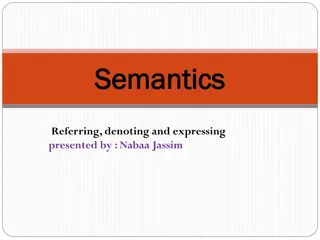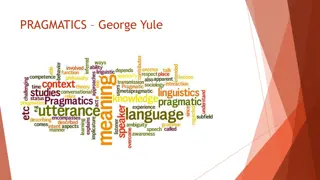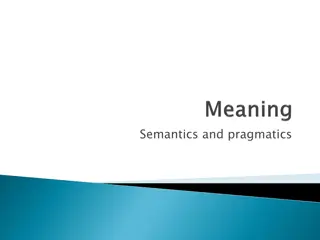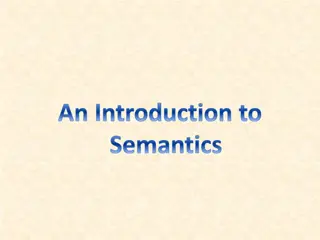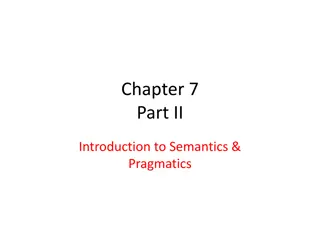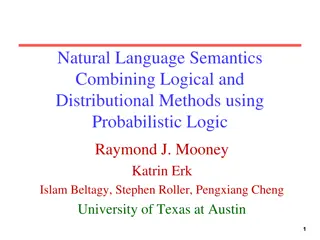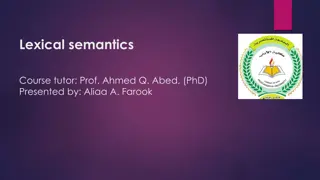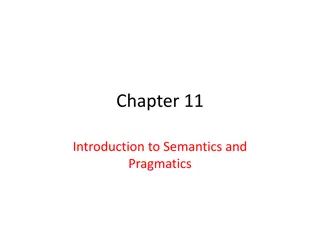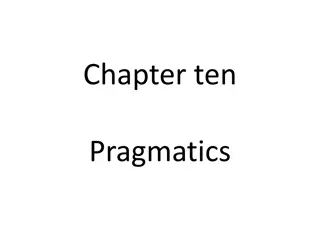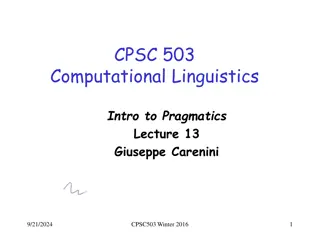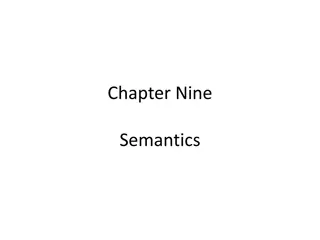Introduction to Meaning in Language: Semantics & Pragmatics
Meaning in language is explored in this introductory lecture, covering aspects such as communication, semiotics, linguistic channels, and approaches to studying meaning. The process of encoding messages, signal transmission, noise interference, and decoding are discussed within the context of communication channels. Additionally, the concepts of iconicity and conventionality in signs are explained, shedding light on how meaning is conveyed through linguistic forms.
Download Presentation

Please find below an Image/Link to download the presentation.
The content on the website is provided AS IS for your information and personal use only. It may not be sold, licensed, or shared on other websites without obtaining consent from the author.If you encounter any issues during the download, it is possible that the publisher has removed the file from their server.
You are allowed to download the files provided on this website for personal or commercial use, subject to the condition that they are used lawfully. All files are the property of their respective owners.
The content on the website is provided AS IS for your information and personal use only. It may not be sold, licensed, or shared on other websites without obtaining consent from the author.
E N D
Presentation Transcript
Semantics Lecture 1 Meaning in Language: An Introduction to semantics & Pragmatics and
Lecture 1: Introduction 1.1 Communication 1.2 Semiotics: some basic notions 1.3 Language and other communicative channels 1.4 Characteristics of linguistic channels 1.5 Approaches to the study of meaning 1.6 The linguistic study of meaning 1.7 Branches of the study of meaning
1.1 Introduction Meaning makes little sense except in the context of communication. 1.1.1 A simple model Let us begin with a simple model, as shown in Fig. I.I . In the model, the process begins with a speaker who has something to communicate, that is, the message. Since messages in their initial form cannot be transmitted directly, they must be converted into a form that can be transmitted, namely, a signal. In ordinary conversation, this involves a process of linguistic encoding, that is. translating the message into a linguistic form, and translating the linguistic form into a set of instructions to the speech organs, which, when executed, result in an acoustic signal. The initial form of this signal may be termed the transmitted signal.
Every mode of communication has a channel, through which the signal travels: for speech, we have the auditory channel, for normal writing and sign language, the visual channel, for Braille, the tactile channel, and so on. As the signal travels from sender to receiver, it alters in various ways, through distortion, interference from irrelevant stimuli or loss through fading. These changes are referred to collectively as noise. Once the signal has been received by the receiver, it has to be decoded in order to retrieve the original message.
1.2 Semiotics: some basic notions 1.2.1 Iconicity Signs can generally be classified as iconic or arbitrary. Iconic signs are those whose forms mirror their meanings in some respect; signs with no natural analogical correspondences between their forms and their meanings are called arbitrary. A simple example is provided by the Arabic and Roman numerals for "three": 3 and III. Such numbers incorporate "threeness" into their shape, and thus they are iconic. The majority of words in a natural language are arbitrary. However, the so-called onomatopoeic words display a degree of iconicity, in that their sounds are suggestive (to varying degrees) of their meanings: bang, miaow, splash, cuckoo, crack, ring, howl, etc
1.2.2 Conventionality Many of the signs used by humans in communication are natural in the sense that they do not have to be learned. The sort of signs which are natural in this sense will include facial expressions like smiling, frowning, indications of fear and surprise, and so on, perhaps many of the postural and proxemic signs that constitute the so-called 'body language', are likely to be the most cross-culturally interpretable. Other signs have conventionally assigned meanings; they have to be specifically learned, and are likely to differ in different communities. Linguistic signs are the prototypical conventional signs. Additionally, obscene or offensive gestures, for instance, can vary quite remarkably cross culturally: I was once reprimanded for pointing the soles of my feet at the Prime Minister of Iraq (in Arab culture this is disrespectful).
1.3 Language and other communicative channels The signs that accompany language can be divided into two major types paralinguistic and non-linguistic. The defining characteristic of paralinguistic signs will be taken here to be an extreme dependence on the accompanying language. Either they cannot be produced except during speech (because they are carried on the voice), or they cannot be interpreted except in conjunction with accompanying language. Examples of the first variety are abnormal volume, tempo, pitch, and voice quality; to function as signs, there must be a departure from some (personal) baseline or norm. For instance, abnormally high volume, fast tempo, or high pitch typically signal a heightened emotional state. Examples of the second variety include pausing, emphatic gestures, and gestures which metaphorically depict, for instance, direction of motion. Not all the signs that occur alongside language are paralinguistic. For instance, one may smile or frown while speaking. But smiles and frowns (and many other signs) are perfectly interpretable and capable of being produced in the absence of any accompanying language. These are therefore to be considered as non-linguistic. 1. 2.
1.4 Characteristics of linguistic signs Paralinguistic signs are typically natural& iconic, whereas linguistic signs are for the most part arbitrary and conventional.
1.4.2 Signs at different linguistic levels 1. A linguistic sign may be no more than a phoneme (or two): this is one interpretation of the sl- of slimy, slovenly, slug, slag, slum, slink, slattern, slut, slob, etc. which seems to indicate something unpleasant, or the gl- of glare, glimmer, glitter, glisten, glow, gleam, etc. which all have something to do with light effects. 2. Other signs occur at higher levels of linguistic organization, from morpheme level (e.g. the -s of dogs), through word level (e.g. denationalization),clause level (e.g. the formal difference between John is here and Is John here? which signals that one is a question and the other a statement), sentence level (e.g. We'll do it as soon as you arrive), up to text level (e.g. the fact that a stretch of text constitutes a sonnet is indicated by the form of the text as a whole: this form therefore constitutes a high- level sign).
The fact that a sign manifests itself at a particular level does not entail that it is to be interpreted only at that level. Consider: The ed of John kissed Mary, a bound morpheme, semantically situates the time relative to the moment of utterance of the whole event symbolized by John kiss Mary.
1.6.2 What are we trying to achieve? I.6.2.1 How meaning varies with context The meanings of all linguistic expressions vary with the context in which they occur. Some variations, like the sex of the doctor in Our doctor has just married a policeman and Our doctor has just married an actress can be predicted by general principles; other variants are less, or not at all predictable. Semanticians seek a revealing account of contextual variation.
I.6.2.2 Kinds of meaning There are different sorts of meaning, each with different properties. For instance, whatever the difference in meaning between (3) and (4), it does not affect the truth or falsity of the statement: (3) Old Joshua Hobblethwaite popped his clogs last week. (4) Old Joshua Hobblethwaite passed away last week.
I.6.2.3 Systematicity and structure; possibility of formalization All semanticians are to some extent looking for regularities and system in the way meanings behave, as this leads to maximally economical descriptions of meaning.
I.6.2.4 New meanings from old A striking feature of linguistic expressions is their semantic flexibility: beyond their normal contextual variability, they can be bent to semantic ends far removed from their conventional value, witness She swallowed it hook, line and sinker.
I.6.2.5 Role(s) of context There is also general agreement that context is of vital importance in arriving at the meaning of an utterance. The role of context ranges from disambiguating ambiguous expressions as in We just got to the bank in time, through identification of referents (who is he, where is there, in time for what, in He didn't get there in time).
1.7 Branches of the study of meaning in language The following are the main broadly distinguishable areas of interest in the study of meaning. 1.7.1 Lexical semantics Lexical semantics studies the meanings of words; the focus here is on 'content' words like tiger, daffodil, inconsiderate, and woo, rather than 'form'/'grammatical' words like the, of, than, and so on. To a non-specialist, the notion of meaning probably has a stronger link with the idea of the word than with any other linguistic unit. 1.7.2 Grammatical semantics Grammatical semantics studies aspects of meaning which have direct relevance to syntax. One problem (with this approach) is that the meaning of syntactic categories (problematic, because not everyone believes they can be assigned meanings). One aspect of grammatical semantics is the meaning of grammatical morphemes like the ed of walked, the er of longer, the re- and the -al of retrial, and so on. 1.7.3 Logical semantics Logical semantics is the study of meaning in natural languages using logic as an instrument.
Notes. There are many models of the linguistic sign. A classic model is the one by the Swiss linguist Ferdinand de Saussure. According to him, language is made up of signs and every sign has two sides: -the signifier: the "shape" of a word, its phonic component, i.e. the sequence of graphemes (letters) -the signified: the concept or object that appears in our minds when we hear or read the signifier Semiotics: the study of signs An onomatopoeia is a word that phonetically imitates the source of the sound that it describes.
